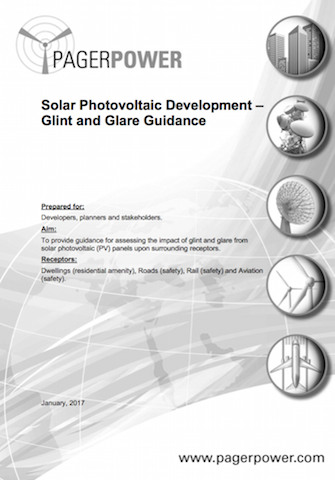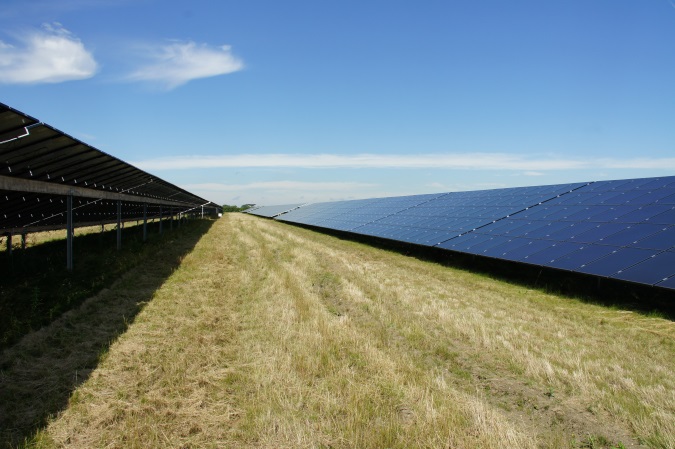This article has now been superseded. The first edition of the Solar PV Development Glint and Glare Guidance is now available. Please follow this link.
Overview
Detailed guidance pertaining to the effects of glint and glare for solar photovoltaic (PV) developments is scarce and this can often lead to uncertainty through the planning process. As industry leading specialists in this area having completed over 1,300 assessments, Pager Power has therefore produced Glint and Glare Guidance for the solar PV industry to aid developers, planner and stakeholders. Over the last few months of 2016, we finalised our first draft of the guidance and we would now really appreciate your input during our peer consultation phase.
 Figure 1: Pager Power’s Glint and Glare Guidance
Figure 1: Pager Power’s Glint and Glare Guidance
Figure 2: Operational Solar Farm
Peer Consultation Opportunity
The guidance has been developed by considering the most common glint and glare assessment requests and stakeholder concerns. Within the guidance, four separate receptor categories are considered, these are:
- Dwellings (residential amenity);
- Roads (safety);
- Rail (safety);
- Aviation (safety).
We are now offering the draft guidance for peer consultation and over the next four weeks and we want your thoughts, comments and questions to ensure the guidance is comprehensive and reasonable based on your experiences.
The ten chapters of the guidance are titled as follows:
- Chapter 1: Overview
- Chapter 2: Consultation
- Chapter 3: Literature Review
- Chapter 4: Modelling Parameter Requirements
- Chapter 5: Glint and Glare Impact Significance
- Chapter 6: Assessing the Impact upon Surrounding Dwellings
- Chapter 7: Assessing the Impact upon Road Users
- Chapter 8: Assessing the Impact upon Railway Operations
- Chapter 9: Assessing the Impact upon Aviation Operations
- Chapter 10: Overall Conclusions
Over the coming weeks, this article will be updated with a general overview of each chapter pertaining to the technical assessment of glint and glare upon each receptor category (chapters 6-9). We will however, be providing you with the whole draft guidance document from week 1.
This week we present to you Chapter 6 of the guidance document, concerning the assessment of dwellings surrounding a proposed solar PV development. A general overview of this chapter is presented below.
Chapter 6: Assessing the Impact upon Surrounding Dwellings
Chapter 6 of the Solar PV Glint and Glare Guidance discusses the process for assessing surrounding dwellings and determining if a significant impact is expected.
In summary, dwellings within approximately 1km of a proposed PV development should be considered for assessment. Where glint and glare effects are geometrically possible, existing and proposed screening should be considered to determine whether the solar reflection would indeed be theoretically visible to a resident from within a surrounding dwelling.
Where a solar reflection is theoretically possible, the total duration throughout the year and throughout the day should be considered to determine the overall significance and the requirement for mitigation.
Chapter 7: Assessing the Impact upon Road Users
Chapter 7 of the Solar PV Glint and Glare Guidance discusses the process for assessing the impact upon road users and determining if a significant impact is expected.
In summary, roads within approximately 1km of a proposed PV development should be considered for assessment. This includes Local, Regional, National and Major National roads.
Where glint and glare effects are geometrically possible, existing and proposed screening should be considered to determine whether the solar reflection would indeed be theoretically visible to a road user. The direction from which a solar reflection originates is also an important factor.
Chapter 8: Assessing the Impact upon Railway Operations
Chapter 8 of the Solar PV Glint and Glare Guidance discusses the process for assessing the impact upon railway infrastructure and determining if a significant impact is expected.
In summary, railway infrastructure within approximately 100m of a proposed PV development should be considered for assessment. The receptors that require consideration are train drivers, railway signals and railway crossings.
The relative location of drivers to infrastructure is an important factor, as well as the technology type present on a signal i.e. the light type and presence of a hood.
Where glint and glare effects are geometrically possible, existing and proposed screening should be considered to determine whether the solar reflection would indeed be theoretically visible to a train driver, at a signal, or towards a level crossing.
Chapter 9: Assessing the Impact upon Aviation Operations
Chapter 9 of the Solar PV Glint and Glare Guidance discusses the process for assessing the impact upon aviation infrastructure and determining if a significant impact is expected.
It is recommended that aerodromes are considered out to 30km from a proposed solar farm though a geometric glint and glare assessment is not necessarily recommended at the greater distances. This is discussed in more detail within the chapter.
The receptors to consider for aviation are pilots in aircraft and Air Traffic Controllers in the ATC Tower. The general methodology is to assess the approach routes towards the runways and to determine whether an Air Traffic Controller could experience glint and glare from a solar PV development. Further consideration of Circling Aircraft, Visual Manoeuvring Areas, Visual Circuits and En-Route Aircraft may also be required.
The US Federal Aviation Administration guidance[1] states the parameters under which solar glint and glare is acceptable to aviation infrastructure using the Sandia Solar Glare Hazard Analysis Tool. Whilst this is comprehensive, a more pragmatic approach is recommended and this is outlined within the chapter.
All of the above should be considered to determine the overall significance and the requirement for mitigation.
Please review Chapters 6, 7, 8 and 9 and let us know your thoughts on the recommendations for guidance. If you have any comments regarding the guidance in its draft form, for this chapter or any section of the guidance, please get in touch.
1. FAA, 2013. Interim Policy, FAA Review of Solar Energy System Projects on Federally Obligated Airports. Last accessed 18.10.2016.
